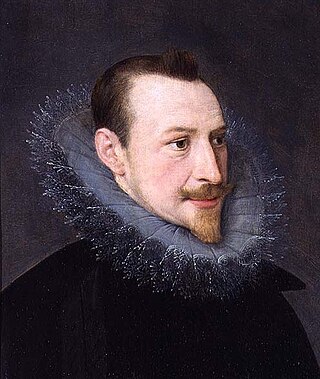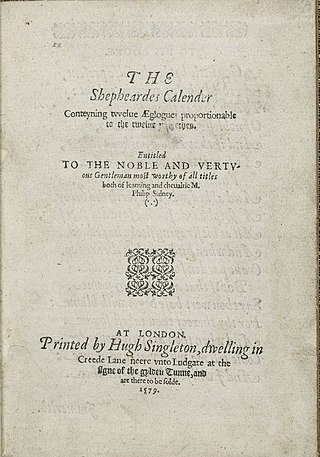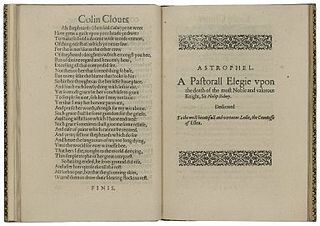Related Research Articles

Edmund Spenser was an English poet best known for The Faerie Queene, an epic poem and fantastical allegory celebrating the Tudor dynasty and Elizabeth I. He is recognized as one of the premier craftsmen of nascent Modern English verse, and he is considered one of the great poets in the English language.

Sir Philip Sidney was an English poet, courtier, scholar and soldier who is remembered as one of the most prominent figures of the Elizabethan age. His works include a sonnet sequence, Astrophel and Stella, a treatise, The Defence of Poesy and a pastoral romance, The Countess of Pembroke's Arcadia.

Gabriel Harvey was an English writer. Harvey was a notable scholar, whose reputation suffered from his quarrel with Thomas Nashe. Henry Morley, writing in the Fortnightly Review, has argued that Harvey's Latin works demonstrate that he was distinguished by qualities very different from the pedantry and conceit usually associated with his name.
Stephen Gosson was an English satirist.
Sir Edward Dyer was an English courtier and poet.
The Oxford Book of English Verse, 1250–1900 is an anthology of English poetry, edited by Arthur Quiller-Couch, that had a very substantial influence on popular taste and perception of poetry for at least a generation. It was published by Oxford University Press in 1900; in its india-paper form it was carried widely around the British Empire and in war as a 'knapsack book'. It sold close to 500,000 copies in its first edition. In 1939, the editor revised it, deleting several poems that he regretted including and adding instead many poems published before 1901 as well as poems published up to 1918. The second edition is now available online.
The Oxford University Press published a long series of poetry anthologies, dealing in particular with British poetry but not restricted to it, after the success of the Oxford Book of English Verse (1900). The Oxford poetry anthologies are traditionally seen as 'establishment' in attitude, and routinely therefore are subjects of discussion and contention. They have been edited both by well-known poets and by distinguished academics. In the limited perspective of canon-formation, they have mostly been retrospective and well-researched, rather than breaking fresh ground.

Mary Herbert, Countess of Pembroke was among the first Englishwomen to gain notice for her poetry and her literary patronage. By the age of 39, she was listed with her brother Philip Sidney and with Edmund Spenser and William Shakespeare among the notable authors of the day in John Bodenham's verse miscellany Belvidere. Her play Antonius is widely seen as reviving interest in soliloquy based on classical models and as a likely source of Samuel Daniel's closet drama Cleopatra (1594) and of Shakespeare's Antony and Cleopatra (1607). She was also known for translating Petrarch's "Triumph of Death", for the poetry anthology Triumphs, and above all for a lyrical, metrical translation of the Psalms.
Several anthologies of religious poetry have been published by Oxford University Press.

The Shepheardes Calender was Edmund Spenser's first major poetic work, published in 1579. In emulation of Virgil's first work, the Eclogues, Spenser wrote this series of pastorals at the commencement of his career. However, Spenser's models were rather the Renaissance eclogues of Mantuanus. The title, like the entire work, is written using deliberately archaic spellings, in order to suggest a connection to medieval literature, and to Geoffrey Chaucer in particular. Spenser dedicated the poem to Philip Sidney. The poem introduces Colin Clout, a folk character originated by John Skelton, and depicts his life as a shepherd through the twelve months of the year. The Calender encompasses considerable formal innovations, anticipating the even more virtuosic Countess of Pembroke's Arcadia, the classic pastoral romance by Sir Philip Sidney, with whom Spenser was acquainted. It is also remarkable for the extensive commentary or gloss included with the work in its first publication, ascribed to an "E.K." E.K. is an intelligent, very subtle, sometimes wrong, and often deeply ironic commentator, who is sometimes assumed to be an alias of Spenser himself. The term sarcasm (Sarcasmus) is first recorded in English in Spenser's poem (October).
The Phoenix Nest was an anthology of poetry by various authors which was "set foorth" by an as-yet unidentified "R. S. of the Inner Temple Gentleman", in 1593. The title page identifies fourteen of the pieces contained therein, although there a total of seventy-nine poems, as well as three short prose pieces.

An Apology for Poetry is a work of literary criticism by Elizabethan poet Philip Sidney. It was written in approximately 1580 and first published in 1595, after his death.
Nationality words link to articles with information on the nation's poetry or literature.
Nationality words link to articles with information on the nation's poetry or literature.
Thomas Drant (c.1540–1578) was an English clergyman and poet. Work of his on prosody was known to Sir Philip Sidney and Edmund Spenser. He was in the intellectual court circle known as the 'Areopagus', and including, as well as Sidney, Edward Dyer, Gabriel Harvey, and Daniel Rogers. He translated Horace into English, taking a free line in consideration of the Roman poet's secular status; but he mentioned he found Horace harder than Homer. Drant's translation was the first complete one of the Satires in English, in fourteeners, but makes some radical changes of content.

The Wilton Circle were an influential group of 16th-century English poets, led by Mary Sidney. They were based at Wilton House, Wiltshire, which was run by the half-brother of Walter Raleigh. Sidney turned Wilton into a "paradise for poets", and the circle included Edmund Spenser, Michael Drayton, Sir John Davies, Abraham Fraunce, and Samuel Daniel.
John Mitford (1781–1859) was an English clergyman and man of letters.
Lodowick Bryskett, was a poet, translator, diplomat and Irish official. He served as Special Ambassador from England to Tuscany in 1600-01.
Complaints is a poetry collection by Edmund Spenser, published in 1591. It contains nine poems. Its publisher, William Ponsonby, added an introduction of his own.

Astrophel: A Pastorall Elegy upon the Death of the Most Noble and Valorous Knight, Sir Philip Sidney is a poem by the English poet Edmund Spenser. It is Spenser's tribute to the memory of Sir Philip Sidney, who had died in 1586, and was dedicated "To the most beautiful and vertuous Ladie, the Countesse of Essex", Frances Walsingham, Sidney's widow.
References
- 1 2 3 4 Fulton, Edward (June 1916). "Spenser, Sidney, and the Areopagus". Modern Language Notes. 31 (6): 372–374. doi:10.2307/2915729. JSTOR 2915729.
- ↑ Maynadier, Howard (April 1909). "The Areopagus of Sidney and Spenser". The Modern Language Review. 4 (3): 289–301. doi:10.2307/3713225. JSTOR 3713225.
- ↑ Edmund Spenser (1815). Haslewood, Joseph (ed.). Ancient Critical Essays Upon English Poets and Poesy. Miscellanea poetica auglicana antiqua,v. 1-2 (Vol. II ed.). London: T. Bensley for Robert Triphook. p. 288. Retrieved 5 November 2015.
- ↑ Bourne, H.R. Fox (1862). A Memoir of Sir Philip Sidney. London: Chapman and Hall. pp. 237, 242, 417. Retrieved 5 November 2015.
- ↑ Palache, Lucy B. (1993). Preminger, Alex; Brogan, T.V.F. (eds.). "Areopagus". The New Princeton Encyclopedia of Poetry and Poetics. Princeton, NJ: Princeton University Press: 98.